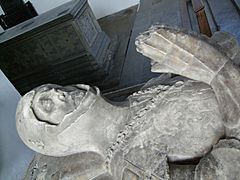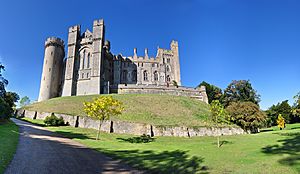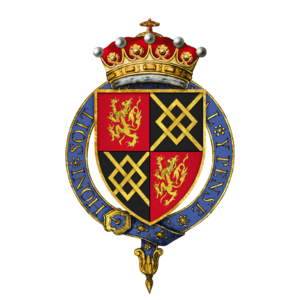John Fitzalan, 7th Earl of Arundel facts for kids
Quick facts for kids
The Earl of Arundel
|
|
|---|---|
| 7th Earl of Arundel | |

John FitzAlan's funeral effigy in Arundel Castle
|
|
| Tenure | 1433–1435 |
| Other titles | Baron Maltravers Duke of Touraine |
| Known for | Military service in the Hundred Years' War |
| Years active | 1430–1435 |
| Born | 14 February 1408 Lytchett Matravers, Dorset |
| Died | 12 June 1435 (aged 27) Beauvais, France |
| Cause of death | Wounded in battle |
| Buried | Arundel Castle, Sussex 50°51′22″N 0°33′13″W / 50.85611°N 0.55361°W |
| Nationality | English |
| Residence | Arundel Castle |
| Wars and battles | Hundred Years' War • Siege of Compiègne • Battle of Gerbevoy |
| Spouse(s) | Constance Fanhope Maud Lovell |
| Issue | Humphrey Fitzalan, 8th Earl |
| Parents | John Fitzalan, 6th Earl Eleanor Berkeley |
John Fitzalan, 7th Earl of Arundel (born February 14, 1408 – died June 12, 1435) was an important English nobleman. He was also a military leader during the later part of the Hundred Years' War. This was a long series of conflicts between England and France.
John's father, also named John Fitzalan, fought hard to claim the title of Earl of Arundel. This fight was not settled until after his father's death. In 1433, John Fitzalan the son was officially given the title.
Even before this, in 1430, John went to France. There, he held several important command positions. He served under John, Duke of Bedford, who was the uncle of the young King Henry VI. John Fitzalan helped take back fortresses and stop local rebellions. His military career ended at the Battle of Gerbevoy in 1435. He refused to retreat, even when facing a larger enemy force. During the battle, he was shot in the foot and captured. His leg was later removed, and he died soon after from the injury.
People at the time thought Arundel was a great soldier. He was a successful commander in France during a tough time for the English. His death was a big loss for England. His son, Humphrey, took over his title but died young. The title then went to John's younger brother, William.
Contents
Becoming the Earl of Arundel
John Fitzalan was born in Lytchett Matravers, Dorset, on February 14, 1408. His parents were John Fitzalan, 3rd Baron Maltravers and Eleanor Berkeley.
A Family Title Dispute
John's father had claimed the title of Earl of Arundel after his cousin died in 1415. However, the cousin's sisters and their families disagreed. They argued that the title should not go to John's father. It is unclear if John's father was ever truly recognized as Earl of Arundel. When his father died in 1421, the argument continued with young John.
Finally, in 1433, John Fitzalan's claim to the title was officially approved by parliament. This was partly because the title was linked to owning Arundel Castle. It was also a reward for his military service in France.
Early Life and Knighthood
As a child, John was supposed to marry Constance. She was the granddaughter of John of Gaunt, a very important royal figure. Constance died by 1429, and John then married Maud Lovell.
In 1426, John Fitzalan was made a knight. This happened at the same time as the four-year-old King Henry VI was knighted. At this time, John was known as "Lord Maltravers." In 1429, he was called "Lord Arundel."
Fighting in France

John Fitzalan followed in his father's footsteps as a soldier in the Hundred Years' War. On April 23, 1430, he left for France. He quickly became known as a skilled soldier, serving under the king's uncle, John, Duke of Bedford.
Key Battles and Commands
- In June 1430, he helped in the Siege of Compiègne, where Joan of Arc had recently been captured.
- He also helped end the siege of Anglure.
- In December 1431, he was in Paris when King Henry VI was crowned King of France. John showed his bravery at a tournament held there.
- Because of his success, he was given important commands. He became the leader of the Rouen army and captain of Vernon.
- In January 1432, he was made captain of Verneuil.
- In April 1432, he was honored by becoming a member of the Order of the Garter. This was a very important group of knights.
Taking Back Fortresses
From 1432, John Fitzalan was in charge of different areas in northern France. One of his main jobs was to take back fortresses in the Île-de-France region. He was mostly successful.
- In December 1433, he was again put in charge of Upper Normandy.
- He also became captain of Pont-de-l'Arche.
- In 1434, he worked with John Talbot, another English commander. They captured Beaumont-sur-Oise and Creil.
- In the summer, Arundel captured more fortresses, making Paris safer from French attacks.
Duke of Touraine
On September 8, 1434, Arundel was also made Duke of Touraine. This was an area held by the French. He received this title as a reward for his good service. It was also hoped he would lead campaigns in that region. In October, he became captain of Saint-Lô. He had to deal with a rebellion there and stop a French advance.
In early 1435, a large rebellion started in western Normandy. Arundel was called to protect Caen. He was sent to take back Rue, where he learned that French forces were fortifying Gerberoy.
His Final Battle and Death
On May 31, 1435, Arundel was at Mantes-la-Jolie when he was ordered to move north. He heard that the French had taken over the nearby fortress at Gerberoy. He quickly moved to attack it.
The English army met a large French force at Gerberoy. Many English soldiers panicked and ran away. But Arundel stayed to fight. In the battle, he lost many of his men. He was hit in the foot by a shot from a culverin, which was an early type of gun.
Capture and Passing
Severely wounded, he was taken to Beauvais as a prisoner. Some historians say Arundel was so upset by his defeat that he refused medical treatment for his foot. His leg was eventually removed, but he died from his injuries on June 12, 1435. England lost one of its youngest and most skilled military leaders.
Where He Was Buried
For a long time, no one was sure what happened to Arundel's body. Some thought he was buried in Beauvais. However, in the mid-1800s, a chaplain found the will of Arundel's squire, Fulk Eyton. Eyton's will said he had brought the earl's body back to England. He had been paid a large sum of money for this.
Arundel had wanted to be buried in the Fitzalan Chapel at Arundel Castle. On November 16, 1857, his tomb in the chapel was opened. Inside, they found a skeleton over six feet tall, with one leg missing. This proved that his body had indeed been brought back to England.
A Great Soldier's Legacy
John Fitzalan's military career happened during a time when England was losing ground in France. Despite this, he was an unusually successful commander. His death was a sad event in England and a cause for celebration in France. People called him the "English Achilles," comparing him to a great Greek hero. Historian Polydore Vergil called him "a man of singular valour, constancy, and gravity."
John and his wife, Maud, had a son named Humphrey. Humphrey was born on January 30, 1429. He inherited his father's title but died young, on April 24, 1438. John FitzAlan's younger brother, William, then became the Earl of Arundel in 1438 when he became an adult.
| Peerage of England | ||
|---|---|---|
| Preceded by John Fitzalan |
Earl of Arundel 1433–1435 |
Succeeded by Humphrey Fitzalan |



